ikfoundation.org
The IK Foundation
Promoting Natural & Cultural History
Since 1988


EARLY FASHION & CLOTH TRADE-CARDS
– a Selection from 1720s to 1850s
The British Museum Collection online includes a unique selection of trade-cards donated in 1818 by Dorothea Banks, dating back to the early 18th century. Parts of this material are of key interest from a textile history point of view, while a search for “trade-cards textile” (images only) gives 405 results – including drapers, mercers, haberdashers, tailors, dyers, textile printers & lace makers. This is obviously a random historical selection if compared to all traders in England and Scotland during this period using these early types of business cards, yet this material presents many valuable details. The aim of this essay is to explain some connections to the cards’ geographical locations, traders' professions and other information, together with a selection of representative images.
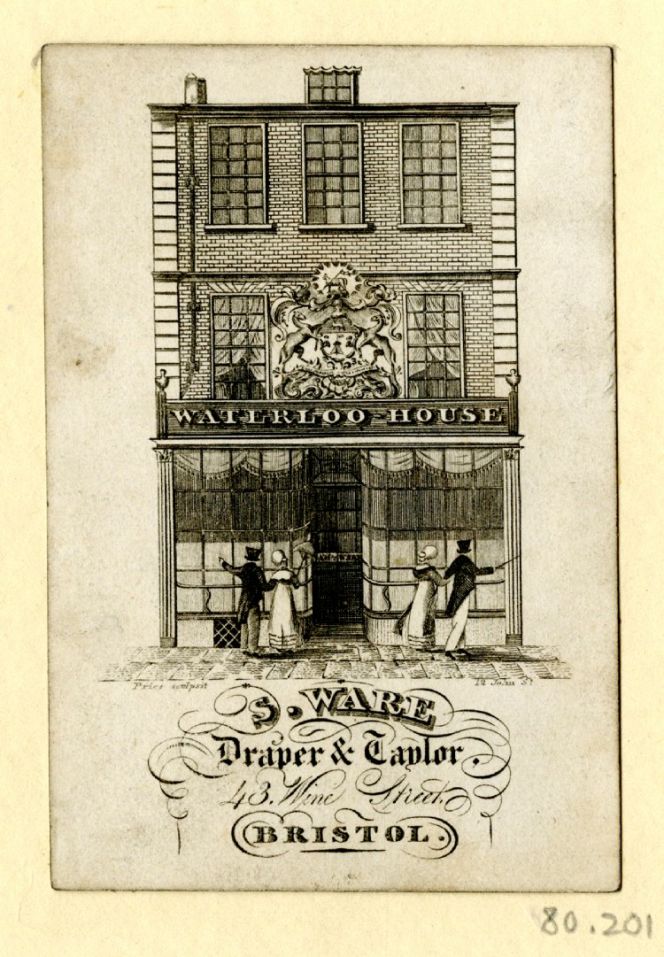 From the late 18th century, some traders used impressive glassed shop windows as a main motif for their trade-cards and from the early 19th century suitable presumptive customers in fashionable clothes were often added. Like for example on this Bristol based Draper & Taylor from c. 1810s. Courtesy of: © Trustees of the British Museum, Banks Collection, no. 80.201 (Collection online).
From the late 18th century, some traders used impressive glassed shop windows as a main motif for their trade-cards and from the early 19th century suitable presumptive customers in fashionable clothes were often added. Like for example on this Bristol based Draper & Taylor from c. 1810s. Courtesy of: © Trustees of the British Museum, Banks Collection, no. 80.201 (Collection online).The tradition of printing trade-cards of various sorts became more widespread during the 17th century, as an early form of business card which traders could circulate to their present customers as well as possible future ones. The oldest textile-connected cards in the British Museum collection originate from the next century and as we will see; these trade-cards of drapers, mercers and other cloth businesses change in appearance over time. A comparative study with my project ‘The Textile History of Whitby 1700-1914’ confirms that cards of this type, have not been preserved or localised in the research from this town. Strengthening the fact that trade-cards were most useful in larger towns and cities when the customers were searching an establishment in the broader area suitable for their needs; with the assistance of street names, describing information, images or maps making it easier for both sellers and buyers. On the other hand, in a small town like Whitby, the relatively few businesses were already known to most presumptive customers.
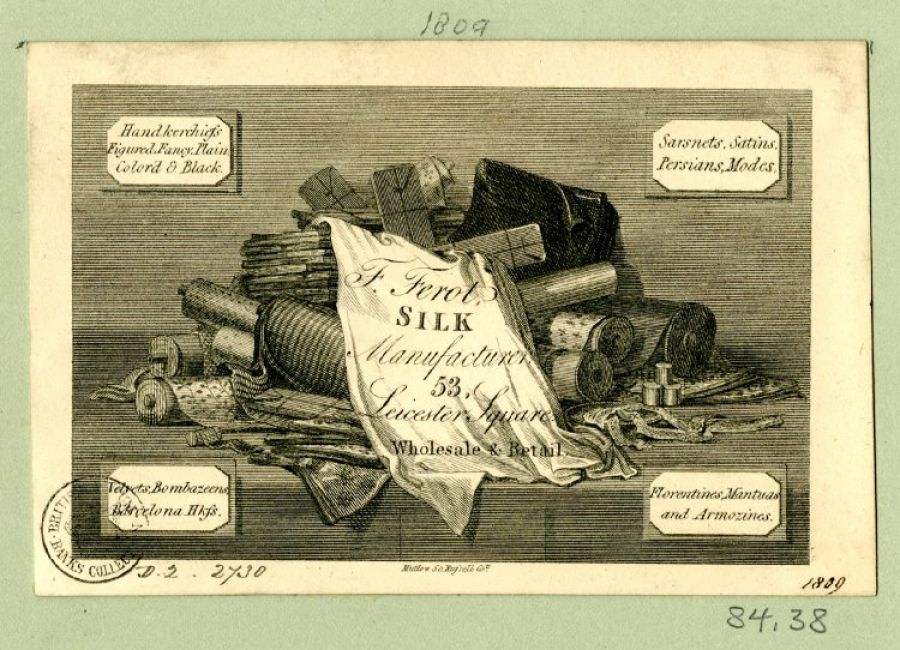 This trade-card once distributed by the London firm ‘F. Ferot Silk Manufacturer 53 Leicester Square’, is unique in its design. None of the other preserved cards in this collection show such close-up details of fabrics, silk reels, ribbons of silk etc. Courtesy of: © Trustees of the British Museum, Banks Collection, no 84.38 (Collection online).
This trade-card once distributed by the London firm ‘F. Ferot Silk Manufacturer 53 Leicester Square’, is unique in its design. None of the other preserved cards in this collection show such close-up details of fabrics, silk reels, ribbons of silk etc. Courtesy of: © Trustees of the British Museum, Banks Collection, no 84.38 (Collection online).The 405 textile trade-cards studied are included in the Banks Collection (The Department of Prints and Drawings, British Museum). These cards are believed to originally have been collected by Sarah Sophia Banks (1744-1818), sister to the naturalist and botanist Joseph Banks (1743-1820), the trade-cards together with other extensive collections were donated to the museum after her death by Joseph Banks’ wife Dorothea Banks (1758-1828). However, some trade-cards pre-date her time of life, and a small number must have been added to the collection a couple of decades after her death.
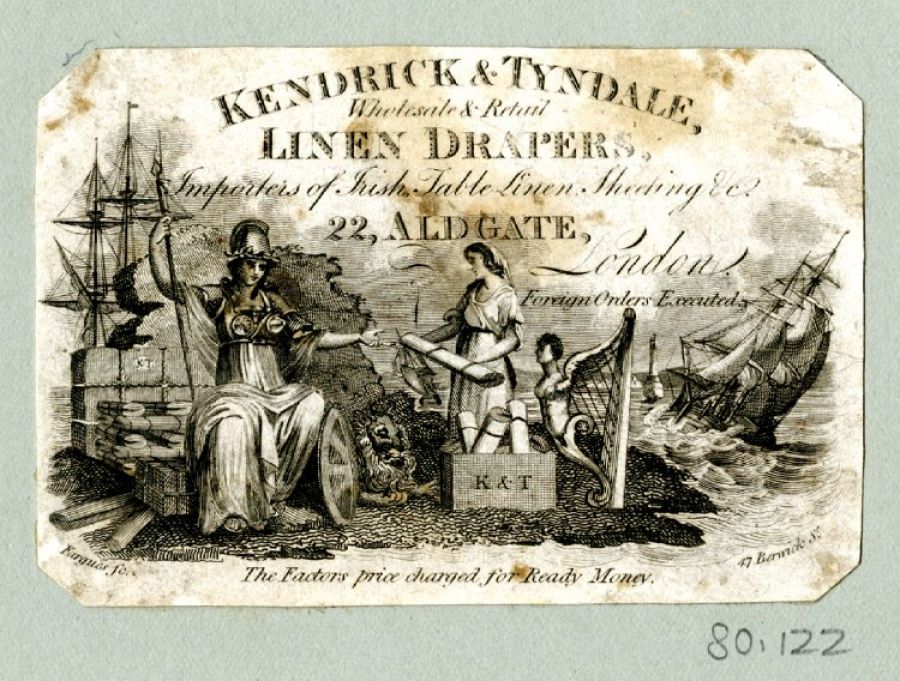 The designs of textile connected trade-cards varied over time and depicted for example impressive buildings, emblems, shop windows, decorative frames, flowers, ladies, royal crowns or as with this London Linen Draper a standardised Imperial motif including images emphasising the importance of trade and the British Empire. Courtesy of: © Trustees of the British Museum, Banks Collection, no. 80.122 (Collection online).
The designs of textile connected trade-cards varied over time and depicted for example impressive buildings, emblems, shop windows, decorative frames, flowers, ladies, royal crowns or as with this London Linen Draper a standardised Imperial motif including images emphasising the importance of trade and the British Empire. Courtesy of: © Trustees of the British Museum, Banks Collection, no. 80.122 (Collection online).The study of the trade-cards for this essay is concentrated on textile traders, their geographical location, possible dating, handwritten notes and other details. A description of traders and their respective professions is detailed below:
TEXTILE TRADERS – Numbers of
- Linen drapers – 128 [whereof 4 female]
- Linen & Woollen drapers – 8
- Mercers/Silk mercers/Mercer & Draper – 72
- Silk dyers/wool or linen dyers – 3
- Weavers – 4
- Woollen drapers – 24
- Various mixed textile businesses – 166 [whereof 5 female] (also including haberdashers/lace work, textile printers, Warehouses etc)
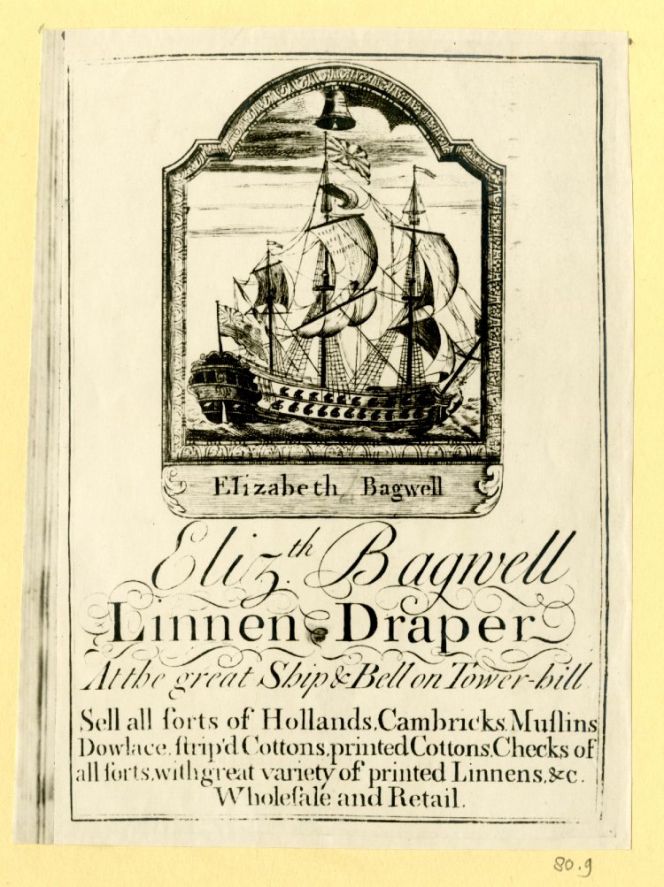 This undated trade-card from the 18th century was distributed by one of few female shop-owners found in the collection; the linen draper Elizabeth Bagwell on Tower Hill in London. Courtesy of: © Trustees of the British Museum, Banks Collection, no. 80.9 (Collection online).
This undated trade-card from the 18th century was distributed by one of few female shop-owners found in the collection; the linen draper Elizabeth Bagwell on Tower Hill in London. Courtesy of: © Trustees of the British Museum, Banks Collection, no. 80.9 (Collection online).A limited number of the included cards can also be regarded as a notice of removal or letter heading, while other motifs are clearly standardised; meaning the traders must have had the possibility of choosing between a selection of designs and then ordering the preferred ones with their name, profession and location. The occasional contemporary handwritten note is also of great interest for any researcher – including prices, names of garments, fabric qualities, dates, etc. – on this occasion, 246 of the 405 trade-cards have notes in ink or pencil.
![One of the oldest trade-cards [bill-head] in the collection. The trader at Ludgate Street in London clearly sold a very expensive green brocade in the summer of 1733! Courtesy of: © Trustees of the British Museum, Banks Collection, no. 84.17 (Collection online).](https://www.ikfoundation.org/uploads/image/5-banks-84-17-jpg-664x381.jpg) One of the oldest trade-cards [bill-head] in the collection. The trader at Ludgate Street in London clearly sold a very expensive green brocade in the summer of 1733! Courtesy of: © Trustees of the British Museum, Banks Collection, no. 84.17 (Collection online).
One of the oldest trade-cards [bill-head] in the collection. The trader at Ludgate Street in London clearly sold a very expensive green brocade in the summer of 1733! Courtesy of: © Trustees of the British Museum, Banks Collection, no. 84.17 (Collection online).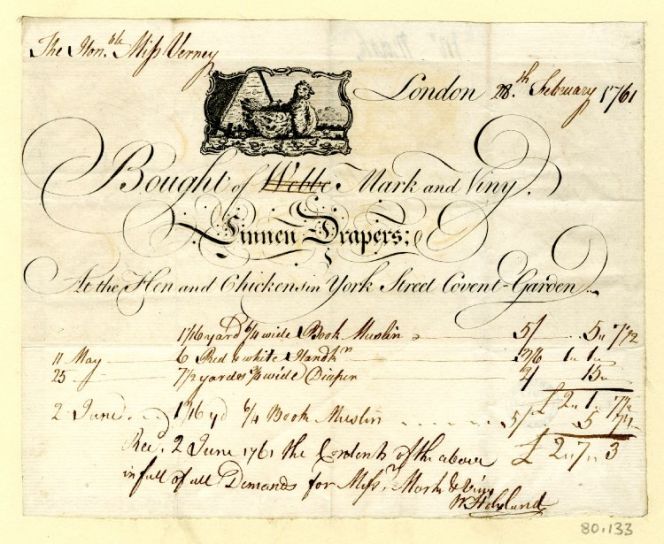 A trade-card/bill-head from Covent Garden in London, dating almost thirty years later gives away useful information about both seller and buyer. Courtesy of: © Trustees of the British Museum, Banks Collection, no. 80.133 (Collection online).
A trade-card/bill-head from Covent Garden in London, dating almost thirty years later gives away useful information about both seller and buyer. Courtesy of: © Trustees of the British Museum, Banks Collection, no. 80.133 (Collection online).The trade-cards originate from the years 1727 to 1856, and 246 out of the 405 cards include a date. Only eight examples exist outside the confines of Joseph Banks’ and his sister’s lifespans, that is to say four cards respectively during the years 1727 to 1739 and 1825 to 1856. The rest are listed chronologically as follows – divided into periods of five years:
YEARS | Dated each period
- 1760-1764 | 4
- 1765-1769 | 6
- 1770-1774 | 2
- 1775-1779 | 4
- 1780-1784 | 16
- 1785-1789 | 39
- 1790-1794 | 28
- 1795-1799 | 39
- 1800-1804 | 32
- 1805-1809 | 33
- 1810-1814 | 28
- 1815-1819 | 7
In other words, approximately 60% of the trade-cards are dated with a year and sometimes also months and days, information written by hand either by the seller, buyer or Sarah Sophia Banks. When these cards were printed, it is likely that the trader’s intention was to use them in the long term – in the cases he/she stayed at the same location – so obviously, to print a year on the card was not practical. But some of the trade-cards, could for example include the beginning of a date, like 17__, 18__ or 183_ to be filled in with an appropriate year (not always done).
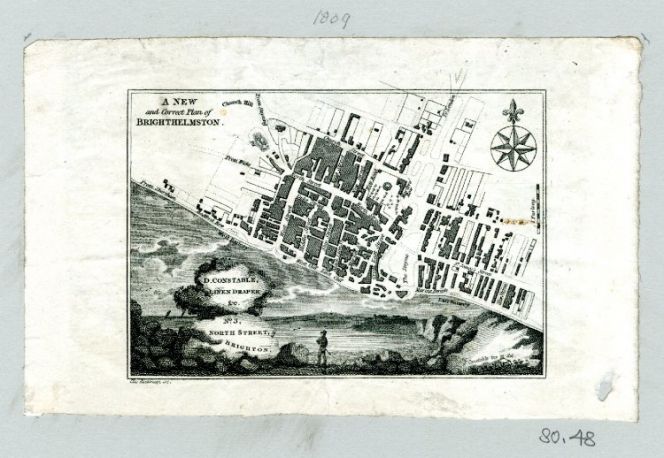 This linen draper’s trade-card dated 1809 has an unusual design including both a landscape illustration and a map of the town, where he went on with his daily drapery business. Courtesy of: © Trustees of the British Museum, Banks Collection, no. 80.48 (Collection online).
This linen draper’s trade-card dated 1809 has an unusual design including both a landscape illustration and a map of the town, where he went on with his daily drapery business. Courtesy of: © Trustees of the British Museum, Banks Collection, no. 80.48 (Collection online).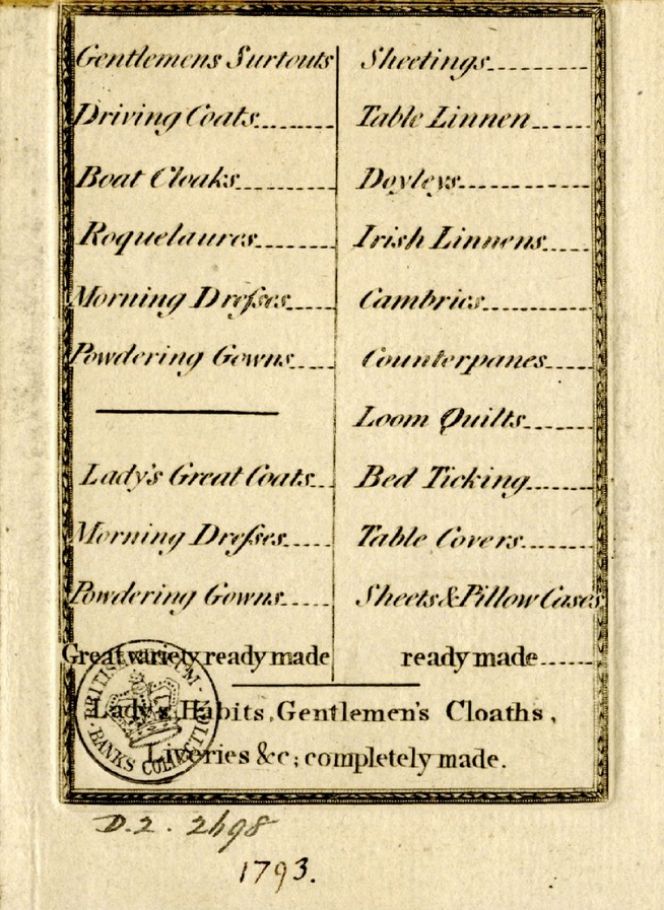 One of the trade-cards lacking information about geographical location, but instead gives a list of various goods for sale in 1793. Courtesy of: © Trustees of the British Museum, Banks Collection, no. 80.18 (Collection online).
One of the trade-cards lacking information about geographical location, but instead gives a list of various goods for sale in 1793. Courtesy of: © Trustees of the British Museum, Banks Collection, no. 80.18 (Collection online).Approximately 75% (310 cards) of the trade-cards originate from London, which is not surprising if we consider that Joseph Banks and his household (also including his sister Sarah Sophia) had one of their residences in the capital. Banks' second estate was situated in Lincolnshire and from this county several examples of textile trade-cards can also be traced (or on the way between there and London): like Boston, Grantham, Horncastle, Lincoln, Norwich, Chelmsford, Colchester and Spalding. Yet with sixteen of the trade-cards their origin cannot be sourced, while the remaining have been located to the following towns and cities in England and Scotland (some places are today part of Greater London):
PLACE – YEAR – NUMBER of TRADE-CARDS
- Abingdon – (undated) – 1
- Bath – (1790, 1791, 1791, 1797, 1799 & 1810) – 6
- Boston – (1801 & 1801) – 2
- Birmingham – (1806 & undated) – 2
- Brighton – (1809 & 1815) – 2
- Bristol – (1782, 1782, 1788, 1788, 1789, 1795, 1799 & 2 undated) – 9
- Canterbury – (1808) – 1
- Chelmsford – (undated) – 1
- Cheltenham – (undated) – 1
- Colchester – (1810) – 1
- Deptford – (1806) – 1
- Devonport – (undated) – 2
- Edinburgh – (1765, 1765, 1776 & 1805) – 4
- Enfield – (undated) – 1
- Exeter – (undated) – 2
- Gainsbro. – (1807 & 1807) – 2
- Glasgow – (1792) – 1
- Grantham – (1848) – 1
- Harrogate – (undated) – 1
- Hollywell – (1789) – 1
- Horncastle – (1807, 1812 & undated) – 3
- Kingston upon Themes – (1813) – 1
- Lincoln – (1807 & 1808) – 2
- Liverpool – (1788, 1791, 1795 & 1796) – 4
- Maidstone – (undated) – 1
- Manchester – (1798 & 1801) – 2
- Newcastle – (undated) – 3
- Newcastle upon Tyne – (1835, 1856 & undated) – 3
- Norwich – (1797) – 1
- Ongar Essex – (1791) – 1
- Pontefract – (undated) – 1
- Portsea – (undated) – 1
- Southampton – (1790) – 1
- Twickenham – (undated) – 1
- York – (1782 & 2 undated) – 3
- Wandsworth – (1773, 1782, 1795 & 1803) – 4
- Windsor – (1791, 1801 & 1806) – 3
- Woolwich – (1814) – 1
- Worchester – (undated) – 1
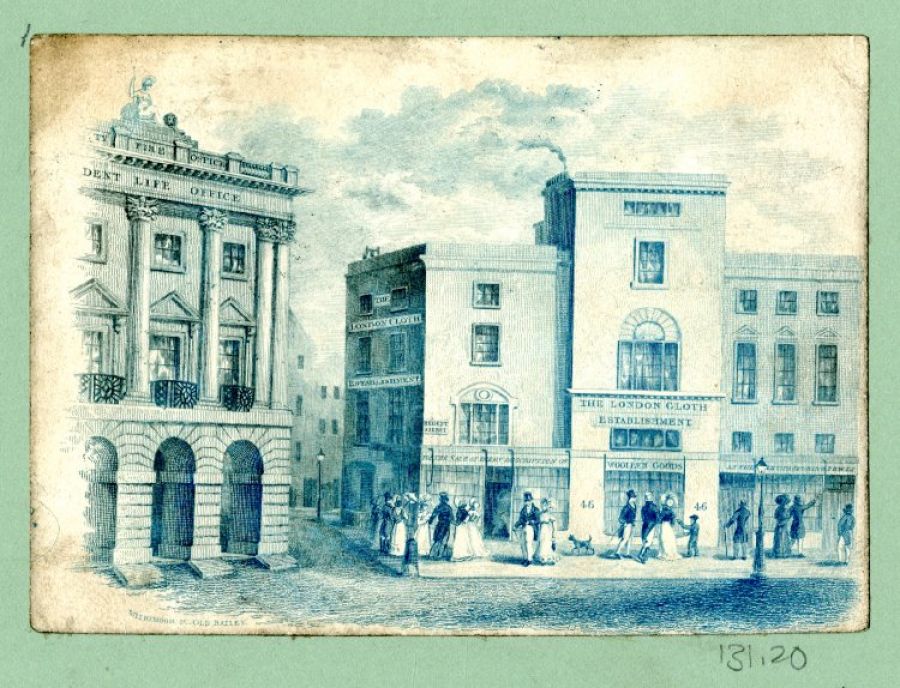 ‘The London Cloth Establishment’s’ trade-card is probably from the 1810s, and is one of eleven cards in colour. Like the illustrated example most of them are just finished off in one bluish, greenish or reddish shade. Courtesy of: © Trustees of the British Museum, Banks Collection, no. 131.20 (Collection online).
‘The London Cloth Establishment’s’ trade-card is probably from the 1810s, and is one of eleven cards in colour. Like the illustrated example most of them are just finished off in one bluish, greenish or reddish shade. Courtesy of: © Trustees of the British Museum, Banks Collection, no. 131.20 (Collection online).The rich information bestowed upon these 405 trade-cards is possible to study from numerous angles, be it by making comparisons with similar prints in other collections or by bringing earlier research/publications into the subject – as a source material it allows for a multifaceted approach! In this essay, the following subjects, for example, are only briefly mentioned or not touched upon at all: the design and size of the cards, amount of text and its content, textile firms included, prices of goods, qualities of fabrics, the customer’s financial circumstances and culture of credit, possession of everyday and luxury wares, exotic goods or female/male customers.
Sources:
- British Museum, Collection online (search words: trade-cards textile).
- Hansen, Viveka, The Textile History of Whitby 1700-1914, Whitby & London 2015 (research material, pre-publishing).
- Wikipedia (search words: trade card).
Essays
The iTEXTILIS is a division of The IK Workshop Society – a global and unique forum for all those interested in Natural & Cultural History from a textile Perspective.
Open Access essays, licensed under Creative Commons and freely accessible, by Textile historian Viveka Hansen, aim to integrate her current research, printed monographs, and earlier projects dating back to the late 1980s. Some essays feature rare archive material originally published in other languages, now available in English for the first time, revealing aspects of history that were previously little known outside northern European countries. Her work also explores various topics, including the textile trade, material culture, cloth manufacturing, fashion, natural dyeing, and the intriguing world of early travelling naturalists – such as the "Linnaean network" – viewed through a global historical lens.
For regular updates and to fully utilise iTEXTILIS' features, we recommend subscribing to our newsletter, iMESSENGER.
been copied to your clipboard




– a truly European organisation since 1988
Legal issues | Forget me | and much more...
You are welcome to use the information and knowledge from
The IK Workshop Society, as long as you follow a few simple rules.
LEARN MORE & I AGREE







